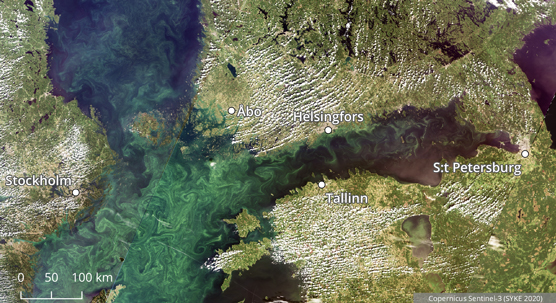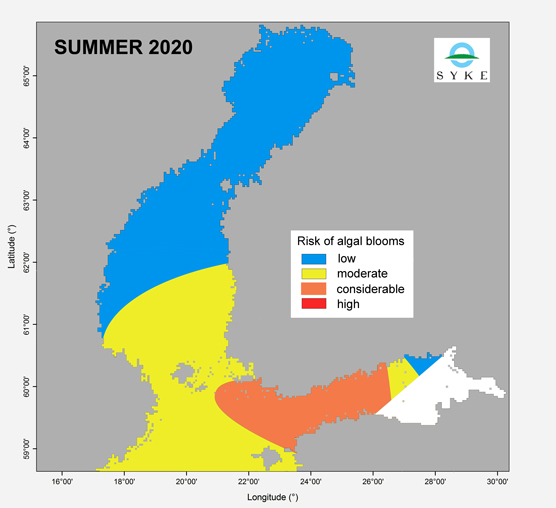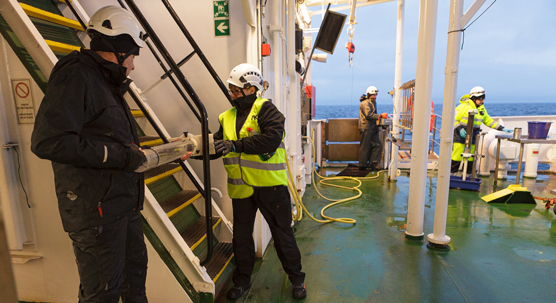Press release 2020-06-04 at 9:00

Satellite images are also used in monitoring the algal blooms of the Baltic. This picture was taken by the Sentinel-3 satellite on the 27th of July 2019. SYKE publishes satellite images about the algal blooms on
TARKKA service and also on the new
marinefinland.fi website.
The risk of significant and widespread cyanobacterial blooms this summer for the eastern Gulf of Finland and the main basin of the Baltic Sea is lower than in summer 2019. In average summer weather conditions, the risk of algae is moderate in the northern part of the main basin of the Baltic Sea, a major part of the Archipelago Sea and in the southern part of the Bothnian Sea this summer. In the Bay of Bothnia and the eastern part of the Gulf of Finland, the risk is low.
The realisation of the risk is determined by the summer weather conditions, as the nutrient situation in the northern part of the main basin of the Baltic Sea is similar to 2018. Many remember that year as a bad cyanobacterial summer, as the weather conditions at that time were very favourable for the birth of cyanobacterial rafts.

Algal bloom risks 2020.
New information on the origin of cyanobacterial blooms in the Baltic Sea
The main basin of the Baltic Sea has enough nutrients for significant and rich cyanobacterial blooms. According to an extensive scientific article on the emergence of cyanobacterial blooms in the Baltic Sea published at the beginning of this year, this has been the case throughout the 21st century. The data from US, Swedish and German researchers consisted of weather, nutrient and cyanobacterial data from the Baltic Sea collected over 40 years. According to the research, the richness of cyanobacterial blooms during summers is mainly determined by the amount of sunshine and surface water temperatures in July. Warm and dry weather increases blooming.
The eastern Gulf of Finland and the entire Gulf of Bothnia were excluded from the research. In general, the nutrient situation in both these regions differs from that in the main basin with the annual amount of cyanobacterial blooms varying more than in the main basin of the Baltic Sea.
Risk assessment of cyanobacterial blooms in the sea areas near Finland
The risk assessment of cyanobacterial blooms in the sea areas near Finland is based on the amounts of nitrogen and phosphorus available for the algae measured during the previous winter. SYKE and the Swedish Meteorological and Hydrological Institute (SMHI) have measured nutrient levels very comprehensively during winter monitoring trips. SYKE and the Finnish Meteorological Institute assess the risk of algal blooms using the Baltic Sea ecosystem model. In addition to winter nutrient levels, the assessment takes into account the development of nutrient concentrations during spring 2020. It provided information on Alg@line monitoring on merchant ships.
The winter nutrient situation provides a regional overview of nutrient availability the following summer. However, summer weather conditions also determine the actual algae situation in the summer in the Finnish sea areas. The cyanobacterial species that bloom in the Baltic Sea thrive in warm water and require plenty of light for their growth. The first algae rafts may appear after a couple of beautiful summer weeks, and continuous high-pressure weather, as in 2018, can lead to very significant and long-lasting blooms.
"The risk forecast issued at the beginning of June is a reminder of potential cyanobacterial bloom areas, but more detailed information of the algal situation can be found in the weekly bulletins and with your own eyes," says Group Leader Harri Kuosa from the Finnish Environment Institute. “We have found that the cyanobacterial blooms in the Bothnian Sea have expanded further north. Elsewhere in Finland, the amount of phosphorus is stable, but in the Bothnian Sea it has doubled in the last twenty years.”
Cyanobacterial blooming usually begins after midsummer at the earliest. Blooming peaks in the Finnish sea areas are usually in July and early August. Algae rafts can still be seen during autumn, but the wide blooms are then usually over.
Last winter’s rainfall and mild weather caused a stronger-than-normal nutrient load from river waters to coastal areas. The nutrient load increases the eutrophication of the Baltic Sea and thus, in the long run, the mass occurrence of cyanobacteria. However, the relationship between the nutrient load of an individual winter and the cyanobacterial bloom the following summer is unambiguously difficult to assess, as nutrients circulate in a complex coastal food web before summer. This issue is being addressed in an extensive MAAMERI project on the Archipelago Sea, funded by the Ministry of the Environment, starting this year.
Changes in cyanobacterial rafts can be fast
Algae masses formed on the high seas can migrate close to coastal areas. The surface blooms of cyanobacteria can move to the southern archipelago and the coast, especially with southwestern and southern winds. Strong wind mixes cyanobacteria with surface water, making the algae more difficult to observe. However, the mass of cyanobacteria does not disappear, but with calm weather it can quickly rise to the surface again.

The research vessel Aranda has collected nutrient data during the winter of 2019–2020. © Image: Ilkka Lastumäki / SYKE
It is good to remember that the amount of cyanobacterial blooms can vary a lot, even in small areas. On the coast and in the archipelago, flow conditions can pile up cyanobacteria, and local nutrient sources can cause algal blooms, especially during a long calm and warm period. In addition, winds can carry cyanobacteria to the shores.
Cyanobacteria in the Baltic Sea can form a variety of toxins and skin irritants. Rich cyanobacterial blooms should always be treated with caution.
National algal reviews are published again
The Finnish Environment Institute reports on the cyanobacterial situation every week until the end of August. The first algal review of summer 2020 is published today, 4 June 2020 at 13:00.
Further information
Algal bloom risk assessment:
Harri Kuosa, Leading researcher, Finnish Environment Institute SYKE, tel. +358 (0) 295 251 106, e-mail: firstname.lastname@ymparisto.fi
Eija Järvinen, Communication Specialist, Finnish Environment Institute SYKE, tel. +358 (0) 295 251 242, e-mail: firstname.lastname@ymparisto.fi
Pictures for media use:
Links: